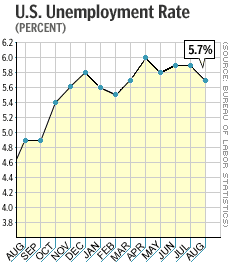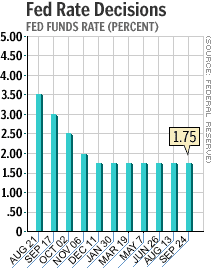NEW YORK (CNN/Money) -
The U.S. unemployment rate is expected to rise again Friday, and a growing number of economists are comparing 2002 to 1992, when the economy managed to keep moving forward, without bringing the labor market along with it.
Economists, on average, expect the Labor Department to report that the unemployment rate rose to 5.9 percent in September after falling to 5.7 percent in August, according to Briefing.com.

While an unemployment rate of 5.9 percent is not bad compared with a 10.8 percent peak in 1982 and a 7.8 percent peak in 1992, jobs are still scarce. The consensus expectation is that a puny 6,000 new jobs were added to non-farm payrolls in September, compared with August's gain of 39,000.
In comparison, most economists think payrolls need to grow by at least 125,000 jobs per month in order to keep the unemployment rate from rising.
U.S. businesses, having cut about 1.8 million jobs during a recession that began in March 2001, are getting more production out of fewer workers -- good news, eventually, for corporate profits, but bad news, temporarily, for labor markets.
"Even more than the early 1990s, this is a jobless recovery," said Bank One chief economist Diane Swonk. "Productivity growth is playing twice the role it played in the early 1990s in driving economic gains, which means less payrolls growth."
Businesses are in no hurry to start hiring workers again, and won't do so until they're absolutely sure the economy is on the mend and demand for their goods and services is rising. Swonk said she didn't expect the labor market to fully recover until 2004, and there certainly are few signs companies are through cutting jobs.
On Thursday, the Labor Department said new claims for unemployment benefits in the week ended Sept. 28 were above 400,000, a benchmark level indicating labor-market weakness, for the sixth straight week. And the four-week moving average, which is more stable than the weekly data, rose to 423,000, the highest level since May.
"Unfortunately, at current levels, and coupled with the extraordinarily low level of labor demand, the claims numbers are still consistent with flat or falling payrolls and a rising unemployment rate," Ian Shepherdson, chief U.S. economist at High Frequency Economics Ltd., said in a note. "There's no real relief in sight here yet."
| Related stories
|

|
|
|
|
Meanwhile, the Institute for Supply Management, in its report on September non-manufacturing activity, said its index of hiring in the service sector -- by far the biggest employer in the economy -- fell to 46.6 from 47.3. Any level below 50 means jobs are being cut, and the index has been below 50 for 19 straight months.
In another report, the Conference Board's help-wanted advertising index, a measure of corporate demand for labor, fell to 41 in August from 44 in July -- a far cry from its year-ago level of 53.
Want more bad news? The Economic Policy Institute, a think tank that studies labor issues, noted that the "jobs deficit" -- the gap between the number of jobs available and the number of people out of work -- spread to 5.13 million jobs in July, the latest month for which data are available. The deficit has swollen by about 4 million jobs since December 2000.
"It does not bode well for unemployment that, not only are more unemployed workers seeking jobs, but there also are fewer jobs to go around," EPI economist Jeffrey Wenger said in a note.
More job cuts, rate cuts on the way?
In what would seem to be a rare positive development for the labor market, job-cut announcements dropped 41 percent in September to their lowest level in 22 months, according to outplacement firm Challenger Gray & Christmas, which keeps track of corporate layoffs.
But the firm's CEO, John Challenger, cautioned against getting too excited about the drop, noting that the 70,057 layoffs announced in the month were nearly double the average rate of monthly job cuts announced between July 1990 and June 1992, during the last "jobless" recovery.
"Layoffs are still very high, and the economy seems to be showing little sign of pulling out of the doldrums," Challenger said. "These lower cuts may just mean that we aren't seeing any further dips right now -- that we're just in this kind of steady, low-wattage kind of state."

That could change, Challenger warned, in the fourth quarter, which has been the worst quarter for job cuts in five out of the past seven years. Many companies cut costs dramatically in the fourth quarter to try to meet full-year profit goals, and the biggest cost for most businesses is labor.
If the labor market weakens significantly, that could be the impetus to force Federal Reserve policy makers to finally cut their target for short-term interest rates. The Fed cuts rates to make borrowing cheaper and encourage spending, and it cut rates 11 times in 2001.
Policy makers have left rates alone so far this year, uncertain of the direction the economy might take. Market expectations for another cut have grown in recent weeks, however, as signs of a slowdown have accumulated.
"My guess is that there will be sufficient further weakness in the economy -- in particular, in the next three jobs reports -- to shift the center of gravity of [Fed policy makers] to the easing side of the boat before Christmas," said Rory Robertson, interest rate strategist at Macquarie Equities USA.
Though Fed officials spent the week expressing optimism that the economy still seemed to be on the right track, they also pointed out a number of risks, including the job market.
"If household perceptions of job security and future job prospects head south, rising caution could seriously undermine spending," Richmond Fed President Alfred Broaddus said in a speech Wednesday.
"All this is reminiscent of the 'jobless recovery' from the early 1990-91 recession," Broaddus said.
Broaddus and other economists have noted that the labor market's silver lining, higher productivity, will hopefully translate into greater production and more hiring.
But the sooner that happens, the more comfortable consumers -- whose spending fuels two-thirds of the total economy -- will be.
Consumers have kept the economy afloat with their spending, much of which has been fueled by increased debt. If they grow increasingly worried about their jobs, they might not be willing -- or able -- to take on more debt.
"If we have a rising unemployment rate, we're going to see some tightening in credit terms to the household sector, which has been keeping things going," said Paul Kasriel, economist at Northern Trust Co.

|

